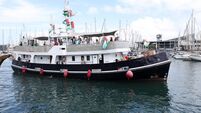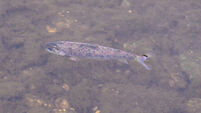Cork rolls out 'early-warning system' to identify buildings at risk of dereliction

A derelict site at 42, Cornmarket St, Cork.
Buildings in the heart of Cork City are set to undergo regular visual ‘health-checks’ as part of a major blitz against dereliction.
And the city’s historic Marsh is to be the focus of a new pilot project which aims to tackle vacancy and dereliction in what is the oldest inhabited area of the city.
The new strategies are the latest efforts by Cork City Council to tackle dereliction amid renewed efforts from the Government to breathe new life into cities and towns.
Council planners and technicians have begun a street-by-street inspection process to identify buildings with the “early warning signs” of potential dereliction.
They have identified a number of individual structures, including several business premises along the city’s historic spine and on several side streets, with peeling paint, loose masonry, and vegetation growing from gutters.
The property owners or occupiers of these buildings will now be issued with a Section 11 notice under the Derelict Sites Act, 1990, which will specify the measures the local authority considers to be necessary in order to prevent the site from becoming a derelict site, and to ensure it avoids being entered on the council’s derelict sites register (DSR).
Other properties showing less concerning signs have been listed for further inspection within three months.
The council is also finalising plans for a pilot project for a defined area within the Marsh area, bounded on the south by Sheare’s St, north along Moore St and Millerd St to Grenville Place, then east along the quay to Grattan St, and south to take in a large block between Adelaide St and St Peter’s St at North Main St, to continue south to Sheare’s St junction with Liberty St.
City Hall said it is a largely residential area “interspersed with institutional and quasi-industrial uses”, and is a prominent gateway location on the northwest fringe of the city centre.
However, officials said dereliction in the area is largely the result of site assembly by institutions and speculators.
The five-stage pilot project has begun with a desktop and ground survey to identify derelict or long-term vacant or under-utilised sites.
The council will contact the identified property owners and invite them to attend ‘clinics and workshops’ where the range of available grants and supports to help renovate or restore derelict sites will be outlined.
Property owners who engage will be offered advice and support, but for those who don’t, and whose sites look likely to remain derelict, consideration will be given to placing the sites on the DSR.
Properties on the DSR for two years or more can be considered for compulsory acquisition.
Many of the properties in the target area have been on the DSR for some time already.
Officials said they will consider additional interventions for the area, including building health checks and a specific and targeted regeneration initiative.
Frank O’Connor and Jude Sherry, who have been shining a spotlight on dereliction in Cork City for over 18-months, welcomed the moves.
“Vacancy is a gateway to dereliction,” Mr O'Connor said.
Ms Sherry said: “If the message is sent out that vacancy and dereliction is no longer tolerable, it will send a message to owners bringing them back into use, it will snowball and could lead to a cultural change around this,” she said.
“If they do this well and properly, it could restore confidence in the city.”
But both said a more holistic and strategic approach is required nationally to tackle dereliction and vacancy.










